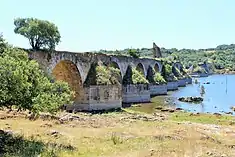Bridge of Ajuda Ponte da Ajuda/Puente de Ayuda | |
|---|---|
 A view of the ruined bridge over Guadiana River showing banks in Portugal and Spain | |
| Coordinates | 38°46′35″N 7°10′14″W / 38.7764°N 7.1706°W |
| Carries | Abandoned |
| Crosses | Guadiana River |
| Locale | Ajuda/Ayuda |
| Official name | Ponte de Nossa Senhora da Ajuda Puente de Nuestra Señora de Ayuda |
| Named for | Nossa Senhora da Ajuda/Nuestra Señora de Ayuda |
| Owner | Portugal/Spain |
| Heritage status | Imóvel de Interesse Público/Bien de Interés Cultural |
| Characteristics | |
| Material | Stone |
| Total length | 453 m (1,486.2 ft) |
| Width | 5 m (16.4 ft) |
| Height | 161 m (528.2 ft) |
| No. of spans | 1 |
| Piers in water | 13 |
| History | |
| Constructed by | Arrudas |
| Construction start | 1510 |
| Opened | 1521 |
| Rebuilt | 1640 |
| Collapsed | 1657 |
| Closed | 1709 |
| Location | |
The Bridge of Ajuda (Portuguese: Ponte de Nossa Senhora da Ajuda, Spanish: Puente de Nuestra Señora de Ayuda) is a dilapidated bridge that crosses the Guadiana River between Elvas and Olivenza.
History



The bridge was constructed between 1520 and 1521, during the reign of King D. Manuel I of Portugal from the left bank of the Guadiana, in the parish of Senhora da Ajuda, along a roadway segment between Elvas and Olivença (and attributed to the "Arruda brothers").[1] During 1597, many of the archways were damaged or destroyed during flooding.[1]
Between 1640 and 1642, Matias de Albuquerque, Governor of the Alentejo, began the refortification of Olivença with the construction of a third or fourth lines of walls.[1] During this period it is possible that the bridge was rebuilt, since it was in a state of ruin at the time of the Governor's visit to Elvas and Olivença.[1][2] However, it was partially destroyed by Spanish forces in 1657. It was then rebuilt in the same century.[1]
In 1705, redoubts were constructed to reinforce the bridge over the Guadiana, designed by Manuel da Maia.[1] In 1709 the bridge was partially demolished by artillery during the War of the Spanish Succession.[1]
The Spanish army, under the command of D. Manuel Godoy annexed the town of Olivença in 1801.[1]
In 1903, in Vila Viçosa, King D. Carlos proposed the reconstruction of the bridge.[1]
On 24 January 1967 the Portuguese government declared the bridge a Imóvel de Interesse Público (Property of Public Interest).[1] This was complimented, on 13 March 2009, when the Spanish government declared the bridge as a Bien de Interés Cultural (Possession of Cultural Interest).[3]
Architecture
The bridge is located in a rural environment, isolated and encircled by wild vegetation, approximately 100 metres (330 ft) from the Chapel of Nossa Senhora da Ajuda, along a segment of abandoned road 12 kilometres (7.5 mi) between Elvas and Olivenza.[1] Although in ruin, the bridge was 453 metres (1,486 ft) long and 5 metres (16 ft) wide, with a platform that was at most 161 metres (528 ft) above the river.[1]
Eight arches remain along the right margin and 5 along the left margin, consisting of inconsistent rounded arches supported by talhamares.[1] The archivolts, with two rows of staves, are supported by quadrangular pillars reinforced by high talhamares.[1] Along the main platform, an old tower was erected along the sixth arch of the right bank, which was constructed over large boulders, now visible along the margin.[1]
See also
References
- 1 2 3 4 5 6 7 8 9 10 11 12 13 14 15 Gordalina, Rosário (2008), SIPA (ed.), Ponte de Nossa Senhora da Ajuda (IPA.00003241/PT041207010020) (in Portuguese), Lisbon, Portugal: SIPA – Sistema de Informação para o Património Arquitectónico, retrieved 29 March 2017
- ↑ Ericeira, p.235
- ↑ "Decreto 52/2009, de 13 de marzo, por el que se declara el Puente de Ajuda de Olivenza como bien de interés cultural, con categoría de monumento". Boletín Oficial del Estado. Retrieved 2 February 2017.
Sources
- Almada, Vitorino de (1888), Elementos para um dicionário de Geographia e História Portuguesa - concelho de Elvas (in Portuguese), vol. I, Elvas, Portugal
{{citation}}: CS1 maint: location missing publisher (link) - Almeida, João de (1948), Roteiro dos Monumentos Militares Portugueses (in Portuguese), Lisbon, Portugal
{{citation}}: CS1 maint: location missing publisher (link) - Calixto, Vasco (19 October 1986), "A ponte da Ajuda", O Século (in Portuguese)
- Cid, Manuel (1989), "A ponte da Ajuda", Estudo Arqueológico, Revista hispano - portuguesa de investigadores en Ciencias Humanas y Sociales, Olivença (in Portuguese)
- Ericeira, Conde da, Historia de Portugal Restaurado (in Portuguese), Porto, Portugal
- Goes, Damião de (1619), Chronica do Felicissimo Rey Dom Emanuel da Gloriosa Memoria (in Portuguese), Lisbon, Portugal
- Marques, A. H. de Oliveira (1984), Chancelarias Portuguesas - D. Pedro I (in Portuguese), Lisbon, Portugal
{{citation}}: CS1 maint: location missing publisher (link) - Pereira, Paulo (1 December 2008), "De Elvas a Olivença. O Renascimento antes de Vitrúvio", Monumentos (in Portuguese), Lisbon, Portugal: Instituto da Habitação e Reabilitação Urbana, pp. 82–91
- Ribeiro, Aníbal Soares (1998), Pontes Antigas Classificadas (in Portuguese), MEPAT- JAE
- Sanchez, Rosa Maria (1994), El Enclave de Olivenza, Cáceres (in Portuguese)
- Viterbo, Sousa, Dicionário Histórico e Documental dos Arquitectos, Engenheiros e Construtores Portugueses, vol. II, Lisbon, Portugal